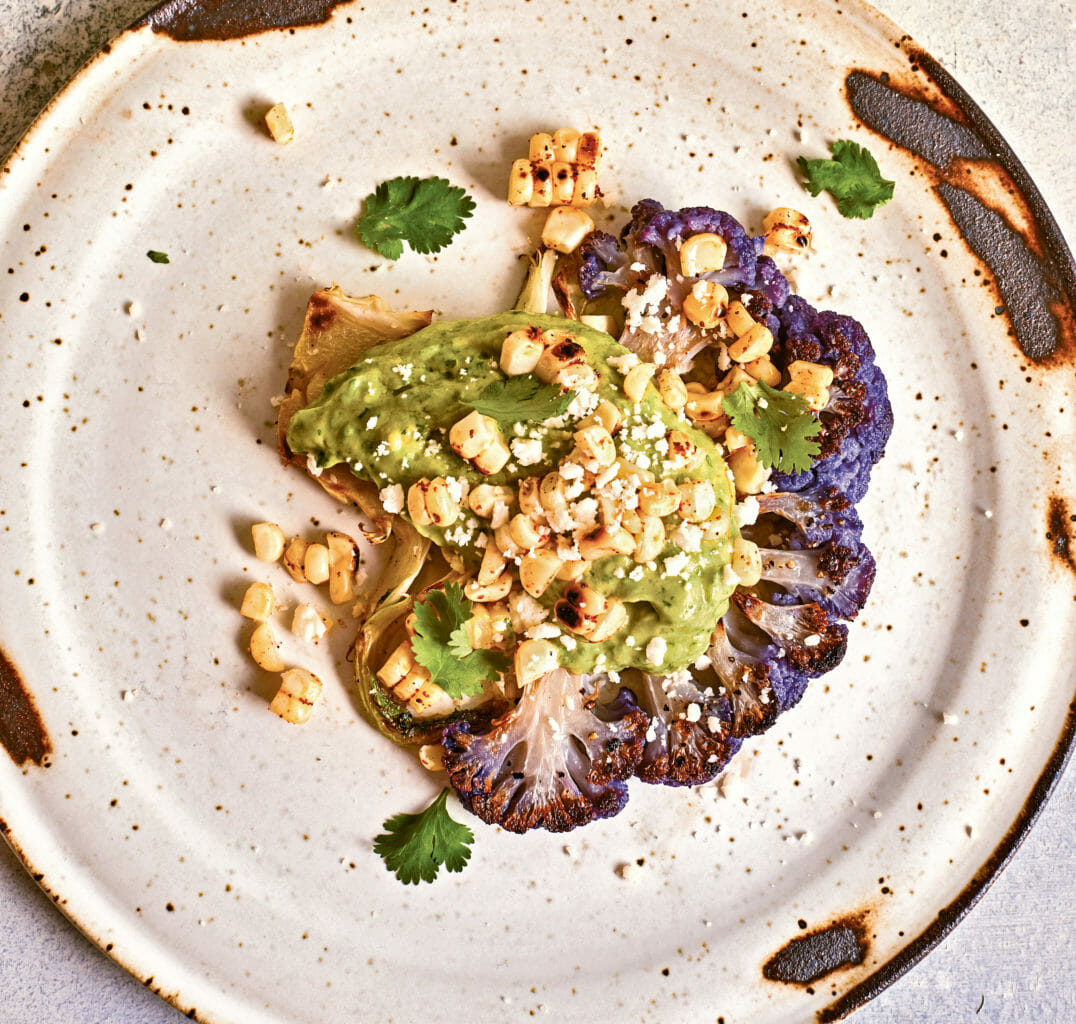COOK THIS: Cauliflower Power by Lindsay Grimes Freedman
Twice a month, our writer cooks from the book and decides if these farm-to-table recipes are worth the investment.
COOK THIS: Cauliflower Power by Lindsay Grimes Freedman
Twice a month, our writer cooks from the book and decides if these farm-to-table recipes are worth the investment.

In case you’ve been hiding in a cave for the past five years, cauliflower is no longer relegated to sad crudité platters. The vegetable’s meteoric rise to trendiness has included appearances in low-carb pizza crusts, vegan Buffalo “wings,” and even less likely places such as smoothies and muffins. Cauliflower Power (Artisan Books; $19.95) by Lindsay Grimes Freedman represents “peak cauliflower,” exploring an even greater recipe repertoire for the vegetable. Freedman was turned on to cauliflower’s potential after her husband was diagnosed with type 1 diabetes, and they started looking for low-glycemic alternatives to their favorite dishes. That’s not to say that they’re all healthy: There’s a stunning amount of cheese in many savory dishes. All gluten-free, the 75 recipes span breakfast, lunch and dinner, as well as snacks and desserts. Yes, desserts. But if you’ve had a creamy bowl of cauliflower soup, it’s not such a stretch to imagine a pureé adding silkiness to an ice cream.
I opted for a savory recipe: Nacho Cauli Tostadas from the Happy Hour chapter. Finely processed cauliflower meal (squeezed of excess liquid) is mixed with taco seasoning, shredded pepper jack cheese and cilantro, formed into flat patties, and baked in the oven. Topped with salsa and vegan cheese, they were delicious, although not exactly crisp like a tostada. Perhaps I needed to squeeze more moisture from the meal, or maybe I made them too thick; still, as a baked veggie fritter, it hit the spot.
If you’re looking for ways to sneak more veggies past your kids (or spouse) at dinnertime, there’s no question that Cauliflower Power will help you do it—who would have thought to add it to waffles, bagel dough, and caramel pudding? But beyond these novelties, you’ll also find some creative, more-traditional recipes such as soups, pasta dishes and casseroles that make the most of this versatile vegetable.
Wendy Underwood tests out cookbooks weekly on Instagram at @kitchenvscookbook.
Excerpted from Cauliflower Power by Lindsay Grimes Freedman (Artisan Books). Copyright © 2020. Photographs by Lauren Volo. Used with permission from the publisher.

Nacho Cauli Tostadas
Makes 24 tostadas; serves 6
You can top these little tostadas with whatever you’re craving. Add some fresh avocado, some shredded barbecued chicken, or a dollop of salsa for a tasty appetizer. Not in the mood for Southwest flavors? Ditch the pepper Jack and Taco Seasoning and substitute Gruyère and chopped rosemary.
4 cups (540 g) medium cauliflower florets
1½ cups (180 g) cubed pepper Jack cheese
3 tablespoons Taco Seasoning (recipe follows)
¼ cup (10 g) chopped fresh cilantro leaves
½ cup Vegan Queso (recipe follows) or salsa
1 avocado, cut into cubes
Preheat the oven to 400°F (200°C). Line 2 baking sheets with parchment paper. Set one oven rack in the middle and one beneath the broiler.
Using the chopping blade on your food processor, process a handful of florets at a time for about 30 seconds, until completely chopped into the consistency of meal (see page 19). Transfer the meal to a clean, thin dish towel or piece of cheesecloth and continue this process until all the florets are chopped. Do this in two or three batches; if you put all the florets in the food processor at once, they won’t get evenly grated.
Once all the meal is in the dish towel, gather the corners and, working over the sink, squeeze out as much liquid as you can. Put the squeezed cauliflower in a large bowl.
Quickly rinse out the food processor (it doesn’t have to be perfectly clean) and add the cubed cheese. Process for about 20 seconds, until chopped.
Add the chopped cheese to the bowl of cauliflower meal along with the Taco Seasoning and cilantro (save a little to use as a garnish). Use a rubber spatula to mix everything together.
Work in batches to bake the tostadas. Use a small ice cream scoop (or a tablespoon) to make eight 2-inch (5 cm) balls of the cauliflower mixture and place them on the prepared baking sheets, about 2 inches (5 cm) apart. Use a spatula to flatten the balls. Use your fingers to re-form the flattened balls into circles as needed.
Bake for 18 to 20 minutes, then broil on high for 2 minutes, until golden brown. Remove from the oven and cook the second batch. Allow each batch to cool on the baking sheet for 5 minutes, then transfer to a cooling rack. Use the first baking sheet for the third batch of tostadas and repeat until all three batches are baked.
Top the tostadas with some queso or salsa, avocado, and more cilantro for garnish. Tostadas are best eaten immediately.
Taco Seasoning
Makes about ¼ cup (28 g)
1 tablespoon chili powder
1 ½ teaspoons ground cumin
1 teaspoon sea salt
½ teaspoon paprika
¼ teaspoon garlic powder
¼ teaspoon onion powder
¼ teaspoon dried oregano
¼ teaspoon red pepper flakes
In a small bowl, mix together the chili powder, cumin, salt, paprika, garlic powder, onion powder, oregano, and red pepper flakes. The mixture will keep in an airtight container for up to 1 month in your pantry.
Vegan Queso
Makes 5 cups; serves 10
1 ½ cups (200 g) cauliflower florets
1 cup (262 g) store-bought medium salsa
½ cup (71 g) raw cashews
1/3 cup (27 g) nutritional yeast
2 garlic cloves
2 teaspoons ground cumin
½ teaspoon sea salt
Coarsely chopped cilantro, for garnish
Bring an inch of water to a boil in a medium saucepan. Place the cauliflower in a steamer basket set over the boiling water. Cover and steam for about 5 minutes, until the florets are easily pierced with a fork.
Combine the cooked cauliflower, salsa, cashews, nutritional yeast, garlic, cumin, and salt in a high-powered blender. Blend on high until smooth and creamy, about 1 minute.
Use a rubber spatula to scrape down the sides and blend for another 10 seconds to puree the queso.
Enjoy the dip warm and garnished with chopped cilantro. Leftovers can be kept in an airtight container in the fridge for up to 1 week. Reheat on the stovetop, whisking in some unsweetened almond milk if the queso gets too thick.

Grilled Cauliflower Steaks with Avocado-Cilantro Sauce
Serves 4
Cauliflower steaks allow you to load on the sauce and toppings in a way that traditional florets can’t. This avocado and cilantro sauce with cotija cheese is light and summery, but you could change the toppings with the seasons (see Variations). Serve these steaks alongside salmon or serve two cauliflower steaks per person for a vegetarian meal.
For the cauliflower steaks
4 cauliflower steaks; cut in ½ inch slices, reserve any additional florets that fall from the head as you slice
3 tablespoons avocado oil
Sea salt and freshly ground black pepper
1 ear of corn, shucked
1 teaspoon smoked paprika
2 tablespoons crumbled cotija cheese
1 tablespoon chopped fresh cilantro leaves, for garnish
For the Avocado-Cilantro Sauce
¼ cup (60 mL) unsweetened coconut cream
1 avocado
Juice of 1 lime
¼ cup (10 g) fresh cilantro leaves
2 garlic cloves
¼ teaspoon sea salt
Prepare a charcoal grill with hot coals or heat a gas grill on high while you prepare the steaks. Alternatively, heat a grill pan on the stovetop over high heat.
Bring a large pot of water to a boil. Blanch 2 of the cauliflower steaks for about 40 seconds, then transfer to a baking sheet. Repeat with the remaining cauliflower steaks and any extra florets that are left after cutting the steaks. Drizzle the blanched cauliflower with 2 tablespoons of the avocado oil, and season with salt and pepper to taste.
Season the ear of corn with the remaining 1 tablespoon avocado oil, salt, pepper, and paprika.
Set a grill mat or piece of aluminum foil on the grill and place the steaks, florets, and corn on top. Grill the steaks and florets for about 5 minutes per side, until the steaks are browned and charred. Transfer to the baking sheet. Flip the corn every 3 minutes. Once it has char spots and is a brighter yellow, about 9 minutes, remove from the grill and place on the baking sheet.
While the cauliflower and corn are grilling, make the sauce: The coconut cream should be smooth; if it’s not, warm it in a microwave for about 30 seconds and stir it until it appears milky. Alternatively, you can warm it in a small pot over medium heat, whisking until smooth.
Place the coconut cream, avocado, lime juice, cilantro, garlic cloves, and salt in a food processor. Process for 10 seconds. Use a rubber spatula to scrape down the sides, then process for another 5 to 10 seconds, until combined and smooth. Set aside.
Once the corn has cooled, stand the ear upright on a cutting board and use a sharp knife to cut the kernels away from the cob.
Transfer the cauliflower steaks to plates. Place a dollop of the avocado-cilantro sauce on each steak. Top with the extra florets, corn kernels, crumbled cotija, and chopped cilantro.
Variations
In fall, top cauliflower steaks with pumpkin spice pecan topping (process 1 cup raw pecans, ⅓ cup refined coconut oil, 2 tablespoons agave nectar, ½ teaspoon pumpkin spice, and ¼ teaspoon sea salt in a food processor for about 30 seconds until combined and smooth), toasted pepitas, and dried cranberries.
In colder weather, try the steaks with melted Gruyère cheese, fried prosciutto, toasted hazelnuts, and chopped fresh sage.
For a spring side, top steaks with Sun-Dried Tomato Pesto (page 148), sliced avocado, toasted pine nuts, and Smoked Chickpea Croutons (page 84).

Double-Chocolate Brownies
Makes nine 3-inch brownies
Using cauliflower as a base makes for brownies that are not only supercreamy, moist, and rich-tasting but also dairy- and oil-free. Serve them with a scoop of ice cream and a drizzle of homemade Caramel Sauce to make a brownie sundae.
3 cups (405 g) cauliflower florets
3 large eggs
½ cup (80 g) coconut sugar
¼ cup (83 g) agave nectar, honey, or maple syrup
1 cup (115 g) blanched almond flour (see Note, page 31)
½ cup (48 g) cocoa powder
1 teaspoon baking soda
½ teaspoon sea salt
¾ cup (131 g) 60% cacao dark chocolate chips
Preheat the oven to 350°F (180°C). Line a 9 by 9-inch (23 by 23 cm) square pan with parchment paper, leaving an overhang on two sides for easy removal.
Bring an inch of water to a boil in a medium saucepan. Place the cauliflower in a steamer basket set over the boiling water. Cover and steam the florets for about 5 minutes, until they’re easily pierced with a fork. Remove the steamer basket and set aside for 10 minutes to cool.
Place the eggs, coconut sugar, and agave nectar in a blender. Blend on high for about 10 seconds, until combined. Add the steamed florets and blend again until smooth.
Add the almond flour, cocoa powder, baking soda, and salt to the blender. Blend again until the dry ingredients are completely incorporated. Use a long-handled spatula to fold in ½ cup (87 g) of the chocolate chips.
Pour the brownie batter into the prepared pan. Spread it evenly across the pan and into the corners. Sprinkle the remaining chocolate chips on top.
Bake for 30 minutes, until the edges start to pull away from the pan and the top springs back when lightly pressed. Remove from the oven and allow to sit in the pan for 5 minutes before pulling up both ends of the parchment paper and placing the brownies on a cooling rack. Let cool for another 5 minutes before cutting the brownies into 9 large squares.
The brownies can be stored in an airtight container in the fridge for up to 1 week.
Follow us
This work is licensed under a Creative Commons Attribution-NoDerivatives 4.0 International License.
Want to republish a Modern Farmer story?
We are happy for Modern Farmer stories to be shared, and encourage you to republish our articles for your audience. When doing so, we ask that you follow these guidelines:
Please credit us and our writers
For the author byline, please use “Author Name, Modern Farmer.” At the top of our stories, if on the web, please include this text and link: “This story was originally published by Modern Farmer.”
Please make sure to include a link back to either our home page or the article URL.
At the bottom of the story, please include the following text:
“Modern Farmer is a nonprofit initiative dedicated to raising awareness and catalyzing action at the intersection of food, agriculture, and society. Read more at <link>Modern Farmer</link>.”
Use our widget
We’d like to be able to track our stories, so we ask that if you republish our content, you do so using our widget (located on the left hand side of the article). The HTML code has a built-in tracker that tells us the data and domain where the story was published, as well as view counts.
Check the image requirements
It’s your responsibility to confirm you're licensed to republish images in our articles. Some images, such as those from commercial providers, don't allow their images to be republished without permission or payment. Copyright terms are generally listed in the image caption and attribution. You are welcome to omit our images or substitute with your own. Charts and interactive graphics follow the same rules.
Don’t change too much. Or, ask us first.
Articles must be republished in their entirety. It’s okay to change references to time (“today” to “yesterday”) or location (“Iowa City, IA” to “here”). But please keep everything else the same.
If you feel strongly that a more material edit needs to be made, get in touch with us at [email protected]. We’re happy to discuss it with the original author, but we must have prior approval for changes before publication.
Special cases
Extracts. You may run the first few lines or paragraphs of the article and then say: “Read the full article at Modern Farmer” with a link back to the original article.
Quotes. You may quote authors provided you include a link back to the article URL.
Translations. These require writer approval. To inquire about translation of a Modern Farmer article, contact us at [email protected]
Signed consent / copyright release forms. These are not required, provided you are following these guidelines.
Print. Articles can be republished in print under these same rules, with the exception that you do not need to include the links.
Tag us
When sharing the story on social media, please tag us using the following: - Twitter (@ModFarm) - Facebook (@ModernFarmerMedia) - Instagram (@modfarm)
Use our content respectfully
Modern Farmer is a nonprofit and as such we share our content for free and in good faith in order to reach new audiences. Respectfully,
No selling ads against our stories. It’s okay to put our stories on pages with ads.
Don’t republish our material wholesale, or automatically; you need to select stories to be republished individually.
You have no rights to sell, license, syndicate, or otherwise represent yourself as the authorized owner of our material to any third parties. This means that you cannot actively publish or submit our work for syndication to third party platforms or apps like Apple News or Google News. We understand that publishers cannot fully control when certain third parties automatically summarize or crawl content from publishers’ own sites.
Keep in touch
We want to hear from you if you love Modern Farmer content, have a collaboration idea, or anything else to share. As a nonprofit outlet, we work in service of our community and are always open to comments, feedback, and ideas. Contact us at [email protected].by Wendy Underwood, Modern Farmer
February 1, 2020
Modern Farmer Weekly
Solutions Hub
Innovations, ideas and inspiration. Actionable solutions for a resilient food system.
ExploreShare With Us
We want to hear from Modern Farmer readers who have thoughtful commentary, actionable solutions, or helpful ideas to share.
SubmitNecessary cookies are absolutely essential for the website to function properly. This category only includes cookies that ensures basic functionalities and security features of the website. These cookies do not store any personal information.
Any cookies that may not be particularly necessary for the website to function and are used specifically to collect user personal data via analytics, ads, other embedded contents are termed as non-necessary cookies.